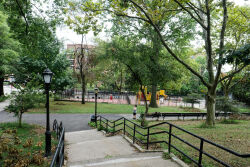Henry Hudson Park
Henry Hudson Monument
Who is this monument dedicated to?
This monument commemorates English explorer and navigator Henry Hudson (1575-1611), who is credited as the first European to “discover” the North River, later named for him. On September 2, 1609, Hudson, the captain of the Dutch ship Halve Maen (Half Moon), directed his ship to drop anchor in the lower bay of what is now known as New York Harbor. Henry Hudson had been hired by the Dutch East India Company to find a sea route through North America to the Far East. The ship sailed up the river that now bears his name, docking off Spuyten Duyvil and attempting travel even further upstream before abandoning the quest, realizing that the river was narrowing. Hudson’s last voyage was in 1611 when, after discovering Hudson’s Bay and claiming it for England, his crew mutinied and cast him adrift. The Dutch East India Company soon afterward establish an outpost that became New Netherland, and eventually the metropolis we know as New York.
How was this created?
In 190,6 civic leaders organized the Hudson-Fulton Celebration to mark the 300th anniversary of Hudson’s arrival and the 100th anniversary of the maiden voyage of Robert Fulton’s (1765–1815) North River Steamboat. They planned a monument here to Hudson and a Hudson Memorial Bridge linking Inwood in Manhattan with Spuyten Duyvil in the Bronx. Local business leaders raised funds for the monument and donated a site, and in 1909, work crews broke ground on the project. Sculptor Karl Bitter (1867-1915) prepared a plaster model of Hudson, and the architectural firm of Babb, Cook and Welch designed the 100-foot-high Doric column, which was erected by 1912. The project was postponed indefinitely when funds ran out and Bitter died in a car accident in 1915.
In 1935, Parks Commissioner Robert Moses (1888–1981) revived the idea for a monument as part of his Henry Hudson Bridge and Park project. Sculptor Karl H. Gruppe (1893-1982), a student of Bitter, adapted his figure of Hudson and sculpted anew two large bronze bas-reliefs for the base of the column. Gruppe also helped complete work on Bitter’s unfinished figure of Pomona for Pulitzer Fountain in Manhattan’s Grand Army Plaza and served as the first chief monument restorer in the late 1930s for the Parks Department.
The monument stands in the park’s northern plaza at its highest elevation. The 16-foot tall figure of Hudson atop the column depicts a resolute Hudson clad in seafaring garb, standing as if balancing himself on a ship’s deck. The relief on the south side depicts Hudson receiving his commission from the Dutch East India Company, and the relief on the north side portrays Europeans and Native Americans at the first Dutch fur trading post on Manhattan. Since the monument was dedicated on January 6, 1938, Henry Hudson has continued to keep watch from his elevated position over the parkway, bridge, and the ever-changing landscape along the river that bears his name.
Check out your park's Vital Signs
Clean & Safe
Green & Resilient
Empowered & Engaged Users
Share your feedback or learn more about how this park is part of a
Vital Park System










